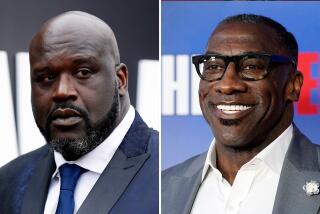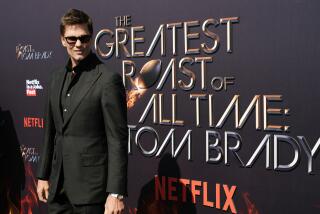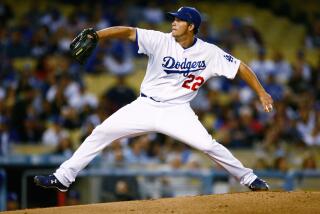Seabiscuit, Gold Cup Needed Each Other
Winning 11 races in 1937, including three victories while burdened with 130 pounds, Seabiscuit began promisingly in 1938, which was to be his lone horse-of-the-year campaign. But by mid-season of 1938, the Seabiscuit camp -- owner Charles S. Howard and trainer Tom Smith -- faced serious credibility problems and the horse needed to prove that his sore legs hadn’t finally betrayed him.
While Hollywood Park, the new track in Inglewood, needed Seabiscuit to run in its first big race, the $50,000 Hollywood Gold Cup, Seabiscuit just as badly needed a win in California to restore his disintegrating image. He got that win, but half the fun was not in the getting there.
In the first part of 1938, the public had the right to question whether Seabiscuit, now a 5-year-old, could stay on top of the mountain. Although his early defeats by a whisker at Santa Anita could be explained by a gaping disparity in weights -- he spotted Aneroid 12 pounds in one race and Stagehand 20 pounds in the Santa Anita Handicap -- his two subsequent wins, in Tijuana and at Bay Meadows, were inconclusive because of the caliber of horse that was gasping behind him.
In early April, the board of directors at Belmont Park had approved a $100,000 purse if Howard and Sam Riddle, the owner of War Admiral, would run their horses in a match race. While Seabiscuit had been declared best handicap horse of 1937, horse-of-the-year honors went to War Admiral, who had swept the Triple Crown and finished the year undefeated in eight starts. The titanic showdown between Seabiscuit and the son of Man o’ War was guaranteed box office.
Belmont set the date as Memorial Day, May 30. Other tracks -- Arlington Park and Suffolk Downs -- also had waved $100,000 checks around, but shortly after Seabiscuit’s victory at Bay Meadows, he was put on a train for the 3,000-mile trip to New York. “War Admiral will know he’s been in a horse race, win or lose,” Smith said in The Blood-Horse magazine. Riddle was less circumspect. “My horse,” he was quoted in a New York newspaper, “will beat the stuffing out of him.”
Of course, this Seabiscuit-War Admiral race never happened. Six days before the race, Seabiscuit was sore and lame and unable to perform in a public workout between races. In Laura Hillenbrand’s “Seabiscuit: An American Legend” bestseller, C.V. Whitney, chairman of Belmont Park, said that he would never consider a rescheduling. “Not if I could buy them for a dime a dozen,” Whitney said.
If what happened in New York was disappointing, what took place at Suffolk Downs a month later careened toward travesty. Seabiscuit and War Admiral were entered to run in the $50,000 Massachusetts Handicap, but just minutes before the race, Seabiscuit was scratched because of a strained tendon on his left foreleg. The crowd of 66,780 booed so loudly that the track announcer, in announcing the injury, felt compelled to add: “ ... And this is positively the truth!” State and track veterinarians had examined Seabiscuit and concluded that his racing career was over.
Worse still for the Suffolk management, War Admiral, the 2-5 favorite, nicked himself in the race, bled from the hoof and finished fourth, far back of Menow, who had received a 23-pound break in the weights. War Admiral had been undefeated for 11 races and 20 months. The only race he lost after Suffolk Downs was the match race against Seabiscuit at Pimlico in November 1938.
Seabiscuit’s prospects continued to plummet after Howard and Smith, disagreeing with the veterinarians in Boston, shipped him to Chicago to run in the Stars and Stripes Handicap at Arlington Park on July 4, only five days after he had been withdrawn at Suffolk. Arlington put 130 pounds on Seabiscuit’s back, and heavy rains turned the racing strip to a messy goo, the kind Seabiscuit never liked, but Howard, fearing another downpour of criticism, went ahead and ran. He would have alienated a record crowd of 50,000 if he hadn’t. The opposition didn’t look that salty, but Seabiscuit finished a well-beaten second behind War Minstrel -- an undistinguished grandson of Man o’ War.
Immediately after the race, Howard said that Seabiscuit would run in the Hollywood Gold Cup in two weeks. Jack L. Warner of Warner Bros. Studios, with the help of hundreds of movieland investors, including Al Jolson, Raoul Walsh and Mervyn LeRoy, had raised $2.225 million to build a track on a bean field in Inglewood, and the Gold Cup was to be the track’s signature race.
Although Seabiscuit made the trip from Chicago to Los Angeles -- his mileage on the rails now approached 30,000 -- no one was laying long green that he would actually run in the Gold Cup. He had been assigned 133 pounds, a weight he’d carried only once in his career, and at least 13 pounds more than the next possible starter.
Silent Tom Smith, the laconic trainer who came by his nickname legitimately, didn’t help in several parries with reporters. This was a typical exchange the week of the race:
Reporter: How is he?
Smith (not looking up from the Daily Racing Form): (inaudible).
Reporter: Will he start on Saturday?
Smith (still reading): (inaudible).
“Smith dislikes about 98% of the newspaper fraternity,” one turf writer wrote, “and he does not take any pains to conceal it.”
Howard was also not immune from criticism.
“Charles S. -- for Scratch the ‘Biscuit -- Howard,” he was described in one account.
The day before the race, when entries were taken, Smith dropped Seabiscuit’s name into the box, but on the slip he put a big, black “X,” indicating that the horse was a doubtful starter. The stewards called Smith in, and told him that the notation was not acceptable.
Smith wouldn’t permit outside veterinarians to examine Seabiscuit, but he finally told the stewards: “All right. Take off the ‘X.’ Seabiscuit will go.”
Nine other horses, carrying between 105 and 120 pounds, lined up to try to beat him. Missing were Lawrin, winner of the Kentucky Derby, and Dauber, the Preakness winner. And War Admiral, who never traveled west of Kentucky during his 26-race career.
The Gold Cup was Seabiscuit’s 79th race. As a 2-year-old, he had run 35 times -- winning five -- and he ran 12 more races in 1936 before trainer Sunny Jim Fitzsimmons, on behalf of Ogden Phipps’ Wheatley Stable, sold him to Howard for either $7,500 or $8,000.
Before a crowd of 50,000, Seabiscuit went off at 7-10, the 14th consecutive race in which he had been favored. Second choice, at 3-1, was owner-trainer Bert Baroni’s three-horse entry of Specify, Star Shadow and No Dice. Baroni flew in Wayne Wright from Chicago to ride Specify, the Hollywood Derby winner a week before and only 3-year-old in the field.
Bing Crosby, who had launched the Del Mar track a year earlier, and Lin Howard, son of Seabiscuit’s owner, were running the improving Ligaroti, whose odds were almost 4-1.
“I paid a fortune for Ligaroti,” Crosby said, “It wasn’t the money, but the unpleasantness of telling friends what a nice racehorse we had, only to see him run bad races. Somehow, I never felt he was a lemon, and I suppose now I can say that patience has its own reward.”
But on July 16, 1938, Ligaroti and the others were overmatched. George Woolf had Seabiscuit in ninth place, ahead of only one horse, after the first half-mile. Specify was up front, more than 12 lengths to the good. “I knew I had a lot of horse under me, and he could win if he wanted to,” Woolf said later. “But Specify sure looked a long way away. I figured Ligaroti was the horse to beat, and I was watching him all the way.”
Urged on by Woolf, Seabiscuit moved into contention approaching the far turn and now only four horses were ahead of him. Coming out of the turn, with an eighth of a mile to run, Seabiscuit had only Specify to beat. Specify was lugging out, prompting Woolf to move Seabiscuit to the rail, to avoid the drifting rival. The margin between them at the wire was 1 1/2 lengths. Whichcee was next, missing second by a nose, and Ligaroti finished fourth, beaten by about seven lengths. The time for 1 1/4 miles was 2:03 4/5. Seabiscuit, paying $3.40 to win, earned $37,150, bringing his career total to $290,305, good for sixth place on the money list.
“In Seabiscuit’s best races, he always lays second or third, crowding the speedburners into the ground,” Woolf said. “I guess he was just a trifle lazy this time. I had to punish the horse three or four times. He’s inclined to loaf a little, and you have to keep pecking at him with your bat. No driving, understand, just enough to make him run. After he passed Specify, he began to loaf again, and I had to spank him a couple of times.”
Still ahead for Seabiscuit were five more wins, including the match-race wins over Ligaroti at Del Mar and War Admiral at Pimlico and -- finally -- the Santa Anita Handicap victory that closed out his career in 1940.
“[In the Gold Cup], Seabiscuit saw Specify way down the track, just pricked up his ears, turned on the gas and came on home like a real champ,” Woolf said. “He’s the greatest horse I ever rode.”
More to Read
Get our high school sports newsletter
Prep Rally is devoted to the SoCal high school sports experience, bringing you scores, stories and a behind-the-scenes look at what makes prep sports so popular.
You may occasionally receive promotional content from the Los Angeles Times.






